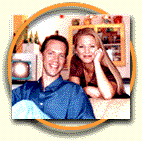
Internet | Reports | Television
The Internet Comes to TV on ‘Wild Wild Web’
Written by Keith Wagner | Posted by: Anonymous
"Convergence" – the possibility of television and computer merging into some hybrid critter – is a hot media buzzword, creating a big enough stir among the broadcast giants to warrant a mention by NBC on the "50th Annual Prime-Time Emmy Awards." The idea seems simple enough: fuse television’s reliability, broadcast quality, and content with the flexibility, personalization, and variety of the Internet. How to implement this idea effectively is not so simple, however, and both television and computer industry executives are racing to introduce the best way to wed these two different media.
"Wild Wild Web," a weekly TV series that focuses on entertainment on the web, is taking steps towards creating an interactive environment—baby steps, perhaps, but steps far beyond what anyone else is doing. "What we’re trying to do is successfully exist in the new media and the old media, and then converge the two," says Alan Chebot, co-creator, executive producer, and director of the series. Now in its second season, the nationally syndicated show provides an inside scoop on quirky, innovative web sites with top-notch content and design. "It’s a unique niche—a mainstream, my-mom-can-watch show about the web," says Bethany Ericson, editorial director of the companion web site, GetWild.com.
The show itself is a straightforward newsmagazine format, with co-hosts Matt Lindley (who is also co-creator) and Beth Lahr introducing viewers to segments about web sites. Four stories are crammed into a 30-minute time slot, and after you subtract eight minutes for commercials, you’re left with four or five minutes per story. If this appetizer leaves you wanting for more, that’s where the web site comes in. At the start of each segment, an audio signal with an encoded URL is transmitted. If you’ve downloaded the free WebChoiceTV program and established an audio connection between your TV and PC, the signal triggers your browser, and bingo!—you’re on GetWild.com and free to explore.
This bit of interactivity is new this season, added when WebChoice approached "Wild Wild Web" with software that was a perfect fit for the program. By using WebChoiceTV, "Wild Wild Web" has wisely decided to focus on what Betsy Frank of MTV Networks, in a recent "New York Times Magazine" article, calls "behavioral convergence." Rather than concentrating on hardware and shoehorning computer functions into the television set (or vice versa), the show takes advantage of the fact that many people already have their television and computer in the same room.
While encoding URLs within another signal isn’t new—it’s existed at least since WebTV was introduced two years ago—WebChoice allows people to use the equipment they already have. "It’s an innovative technique for linking with television via an audio signal," says Andy Berlin, a systems development engineer at WGBH’s Caption Center. Berlin and The Caption Center worked on the live broadcast of the Emmy Awards in September, encoding URL data for a slick Emmy’s site that NBC developed specifically for WebTV users and updated in real-time as the awards show progressed. What "Wild Wild Web" is providing, he says, is "the idea of interactivity without the use of additional hardware." And until now, most encoded URLs only led to commercials, not to additional content. "Most programming has no sister site, or even any idea about the web," Berlin says. Well, Chebot and company clearly get the idea.
After two episodes this season, it was too early for the WebChoiceTV experiment to have yielded any tangible results, but Ericson’s hopes are high: "We’d like to see it work; it’s a very easy thing to try."
Since syndicated TV programs are scheduled at the whim of individual stations, Ericson says the challenge lies in creating programming that will appeal to "the hipsters at 2:00 a.m. and the Sunday morning crowd." TV show and web site are both divided into segments, which neatly lump all entertainment into four categories: Digital Celluloid covers movies and the film industry; Music Box talks to musicians about how technology is changing their music; Sports Edge is the "extreme" sports segment, where Beth Lahr is invariably doing something that requires a helmet (on the second show she jumped from an airplane for a story on skydiving); and then there’s the Green Couch, a catch-all, pop-culture smorgasbord serving up whatever’s hot that week, be it astrology or online gaming or the culture of digital graphic design.
All of the stories address how technology relates to and enhances everyday entertainment, aiming for a hipness factor at the younger end of the 15-35 demographic, but slightly above the presumed computer know-how of viewers. Only sometimes does it stumble—the online postings from someone climbing, then skiing Mount Everest seem a little behind the curve, and they’re clearly addressing the web novice when saying, "You can look at pictures and even download sound clips."
The stories reflect the effort to reach the broadest possible audience. For example, Music Box offerings have ranged from Thomas Dolby to the Ramones to Weird Al Yankovic to electronica/technopop musician Ryuichi Sakamoto. The program’s egalitarian approach to determining content, taking suggestions from everyone on the staff, undoubtedly contributes to the eclectic subject matter.
All this comes from a one-story brick building that used to be a thread factory in Newton, MA, a few blocks from the Charles River. "This is something you’d expect in New York or L.A., not in Boston," says Chebot. While co-hosts Lindley and Lahr both produce their own segments, the show makes smart use of local talent like Catherine Burns and Hilary Weisman, two well-known local producers whose work appears on the show. "There’s a tremendous pool of talent for production here, both for web and TV," says Chebot. "We get to work on a national show, and we get to live in New England."
So far, response to the program has been tremendous. According to Chebot, the web site has received a staggering two million hits per month. "I had a vision as to what the program would be," says Lindley, "and this has turned out pretty close to it." Chebot goes further, saying they’ve achieved more than they set out to accomplish.
"There’s something in the tendency towards the marriage of TV and the computer to enhance the TV experience," says Andy Berlin. What that tendency might ultimately yield is still undefined. Interactivity disrupts a linear narrative, pulling you away from the story, and the two experiences seem mutually exclusive—using the computer versus watching TV, active versus passive. This isn’t to say there’s no potential for some kind of convergence, or that there aren’t uses that will be remarkably appropriate.
For now, it’s a one-way conversation, with signals piped to your computer telling you where to go. But if "Wild Wild Web" continues to make advances within the existing framework like the one they’ve made this year with WebChoiceTV, that could change overnight. Then it’s anybody’s game.
"Wild Wild Web" airs in Boston at 10:30 a.m. Sundays on WFXT 25. And check out the companion website, which stands up well on its own, at http://www.getwild.com/theshow/
'Wild Wild Web' airs in Boston at 10:30 a.m. Sundays on WFXT 25. And check out the companion website, which stands up well on its own, at http://www.getwild.com/theshow/









